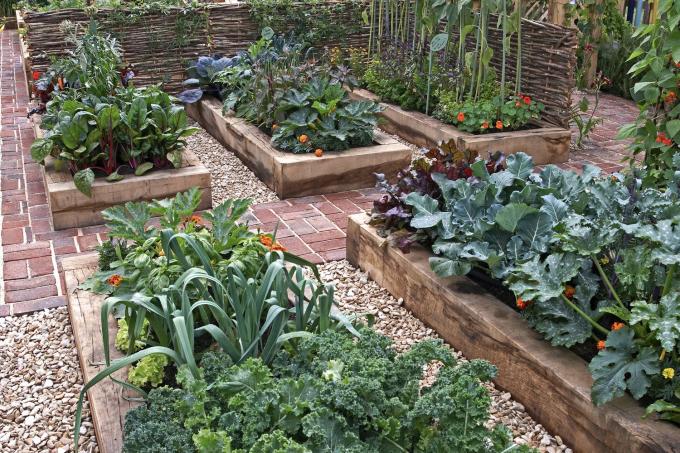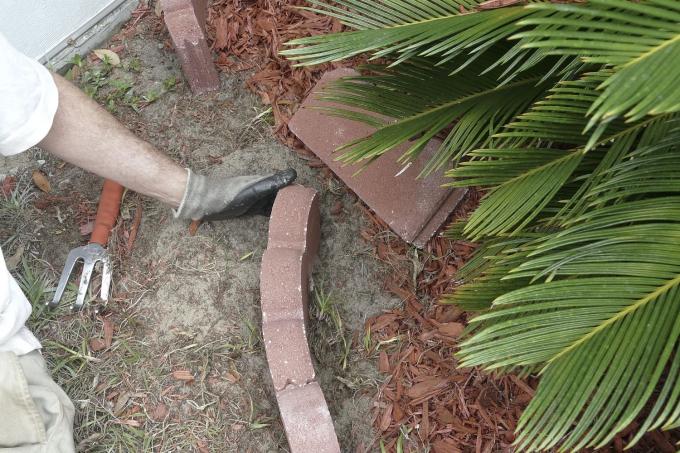A delimited vegetable patch offers many benefits and is easier to build than you might think. Here are four quick ways to do it.

A delimited vegetable bed does not have to be walked on when gardening, so the soil does not compact. As a result, the soil retains its excellent structure, which allows vegetables to thrive very well. Weeding is also far less unpleasant in uncompacted soil. And in general, a slightly raised vegetable bed is harder for weeds and snails to reach, which has a direct effect on the success of the harvest.
Below we have summarized 4 different methods with which you can quickly and easily build your personal, delimited vegetable patch. The following four instructions each result in beds that are approximately 1.2 meters wide and approximately 2.4 meters long. Of course you can adapt the dimensions to the size of your garden or other needs. Please note, however, that beds that are wider than 1.2 meters can cause difficulties when hoeing, watering and harvesting and, in the worst case, have to be entered. The beds, which have an average height of 25 centimeters, should then be filled with a mixture of soil and compost in a ratio of 2:1. If a herb bed is planned, no compost should be added, but sand should be added.
contents
- 1. willow bed
- 2. Bed made of tree trunks
- 3. Vegetable bed made of scarf stones
- 4. Simple vegetable patch made from wooden boards
1. willow bed
First of all, of course, the location of the bed must be determined. Along the future border of the bed, 60 cm long steel rods are driven into the ground with a hammer at a distance of 40 cm. Approximately 25 cm of the sticks should remain above the surface of the earth. Now cut off long, as straight as possible branches from trees or shrubs with a diameter of up to one centimetre. In autumn or winter, the branches are quite dry and difficult to bend. At this time of year you can cut the branches a few (max. Soak in water for four) days. This makes them flexible and malleable.

Soaked or not, the branches are then tied basket-style around the steel rods, once on the outside of one rod, then on the inside of the next rod. At the corners of the bed, the branches are cut accordingly. Once you've wound the branches to the top of the steel rods, your wickerwork still needs to be attached. To do this, place an approx. 60 cm long branch over the wicker fence and push the ends of the branch into the ground on one side of the wicker wall. Repeat this every 50 cm along the entire braided border of the bed. To prevent soil from spilling out of the bed, line the inside of the willow bed with jute.
For a 4' x 8' rectangular willow bed you will need:
- 18 steel rods with a length of approx. 60cm
- a piece of jute
- about 100 long, bendable branches
Oval willow beds are also a real eye-catcher and can be built just as easily. A basic size of 1.5 m x 0.9 m is recommended for them. This shape saves you having to trim the branches at the corners.
2. Bed made of tree trunks
Four tree trunks form the border for this bed. Obtain logs that are as straight as possible and about 30 cm in diameter. If you only have thin trunks, they can be nailed together. A similar height is reached at a slight angle, leaning against the two adjacent tree trunks.

For a 4 x 8 foot log bed you will need:
- two 2.1 m long logs
- two 1.2 m long logs, all four with a diameter of at best 30 cm
tip: More information about Planting a vegetable patch - from the location to the planting plan - we have put together for you.
3. Vegetable bed made of scarf stones
Using concrete formwork blocks (also called hollow blocks) is another easy way to build a vegetable patch. Scarf stones can be obtained from hardware stores and only cost a few euros. The scarf stones are arranged in a rectangle at the desired location and the vegetable patch is ready. The cavities of the scarf stones should also be filled with soil and can be planted with flowers or herbs, for example.

For an approx. 1 x 2.5 meter bed you need:
- 12 concrete formwork blocks with a width of 17.5 cm and a length of 50 cm
- or 20 concrete blocks with a width of 30 cm and a length of 33.3 cm
4. Simple vegetable patch made from wooden boards
Boards from discarded furniture such as chests of drawers, beds or shelves can be ideally recycled for this bed. The prerequisite is, of course, that it is untreated natural wood. If you don't have supplies to reuse, buy four planks of wood at the hardware store. Depending on what's available to you, you can wooden poles or steel rods use.

The approximately 50 cm long wooden posts are driven halfway into the ground at the four corners and on the long sides in the middle with a sledgehammer. 25 cm of the posts should protrude from the ground. Now fasten the boards to the posts from the outside with nails and hammers.
If you decide to use steel rods, drive a 60 cm long steel rod about 35 cm into the ground every 60 to 70 cm. The boards are now leaned against the bars from the inside of the bed. When the bed is filled, the boards automatically press against the bars.

For a vegetable bed made of wooden boards you need:
- 2 boards with a width of approx. 25 cm and a length of approx. 0.7 to 1.2m
- 2 boards with a width of approx. 25 cm and a length of approx. 1.5 to 2.4m
- 6 wooden posts (approx. 3 cm diameter) with a length of 50 cm
- or depending on the length of the boards approx. 10-15 steel rods with a length of approx. 60 cm
With these 4 methods you can easily conjure up a delimited vegetable patch in your garden. Of course there are no limits to your creativity and with a little experimentation real masterpieces can be created.
Now that the vegetable patch is in your garden, it's time to think about the planting. This article tells you why Flowers and vegetables as plant neighbors are excellently suited.



